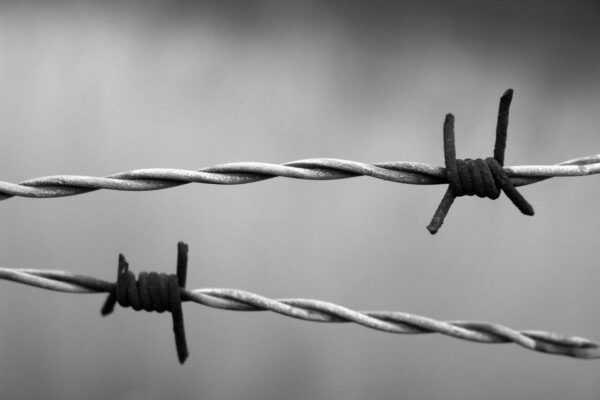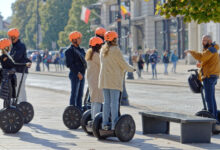Auschwitz-Birkenau, the largest Nazi concentration and extermination camp, stands as a sombre testament to the horrors of the Holocaust and remains an important site of memory and education. Located in the town of Oświęcim in southern Poland, it has been preserved as a museum to honour the memory of the victims and to teach future generations about the atrocities committed within its fences.
For those looking to visit this UNESCO World Heritage site, understanding the transportation options is fundamental for planning your journey. When travelling from Polish cities such as Krakow, Warsaw, or Katowice, various means of transportation are available to reach Auschwitz.

By far, the most common starting point for many visitors is Krakow, approximately 70 kilometres away from the museum. This proximity allows for convenient day trips, with options ranging from organised tours that include round-trip transfers and guided tours of the camp to utilising public transportation like buses and trains that run regularly between the cities.
While Krakow might be the closest major city to the museum, other Polish cities also offer viable routes to Auschwitz. Regular train and bus services are available from across the country, and for those who prefer to travel at their own pace, car rentals provide flexibility for the journey.
Regardless of how you choose to travel, it’s important to allocate sufficient time for the visit. Visitors often spend several hours at the museum, reflecting on the historical significance and magnitude of what occurred at the concentration camp.
Fundamental Information about how to visit Auschwitz from various Polish cities

Before planning your visit to Auschwitz, it is crucial to comprehend the historical significance, acquaint yourself with the museum’s setup, and understand the essential visitor regulations that are in place to maintain the sanctity of this memorial site.
Auschwitz-Birkenau Historical Context
Auschwitz-Birkenau was the largest of the Nazi concentration and extermination camps, operational during World War II.
This site, located in Oświęcim, Poland, represents a dark chapter in history, serving as a symbol of the Holocaust where more than a million people were killed in a systematic genocide. Today, the Auschwitz-Birkenau Memorial and Museum ensures the preservation of this history.

Auschwitz-Birkenau Memorial and Museum Overview
The Auschwitz-Birkenau Memorial and Museum consists of two main parts: Auschwitz I and Auschwitz II-Birkenau. Each section holds various exhibitions depicting life in the camps and the atrocities committed there.

Auschwitz I operates primarily as a museum, hosting several permanent exhibitions. In contrast, Auschwitz II-Birkenau has been preserved as it stood upon liberation, acting as a memorial to those who perished.
Visitor Rules and Regulations
- Timings: Visiting hours vary depending on the time of year. For instance, from June to August, you can enter the museum from 7:30 to 19:00, but the last entry is scheduled so visitors have enough time on site.
- Behavior: Due to the nature of the memorial, a respectful demeanor is required at all times. This includes dressing appropriately and maintaining silence as a sign of respect.
- Tour Duration: To thoroughly engage with the history, plan to spend at least 3.5 hours for a standard tour.
- Guidelines: It is imperative to follow the museum’s rules, such as sticking to your guided tour schedule and wearing comfortable shoes for the visit. Photography is allowed in most areas, but signs will indicate where it is not permitted, especially out of respect for the victims.

Planning Your Visit to Auschwitz from various Polish cities

When you’re planning to visit Auschwitz, it’s essential to consider advance ticket reservations, be aware of the opening hours, prepare suitable attire, and understand the duration of your tour.
Auschwitz Tickets and Reservations
Tickets: To visit Auschwitz, it’s mandatory to book your tickets in advance due to the limited number of visitors allowed per day. You can reserve your spot online through the official Auschwitz-Birkenau Memorial and Museum website.
Reservations: It’s advisable to reserve your ticket as far in advance as possible, especially during peak visiting times like summer.
Opening Hours and Best Times to Visit

Opening Hours: The memorial’s opening hours vary throughout the year, typically extending from 7:30 AM to as late as 7:00 PM during peak summer months.
- The last entry is an hour and a half before closing time.
- June, July, and August are the busiest months, so consider visiting in the shoulder season for a more contemplative experience.
What to Bring and Wear to Auschwitz

What to Wear: Wear comfortable shoes as you’ll be walking extensively. Dress respectfully and be prepared for the weather – it can be variable.
What to Bring: Essentials include a photo ID or passport for entry. Backpacks and large bags are not permitted inside, so pack lightly.
Duration of Visit
Visit Duration: A standard Auschwitz tour with an educator lasts approximately 3.5 hours, but you are free to spend more time if you wish.
- The visit can be emotionally taxing, so allow yourself some time for reflection during and after your visit.
Getting to Auschwitz

When planning your visit to the Auschwitz-Birkenau Memorial and Museum, you have multiple transportation options to consider depending on your starting location in Poland. Most visitors opt for Krakow as their base due to its proximity to Oświęcim, the town where Auschwitz is located.
By Train from Krakow
To reach Auschwitz by train, you can catch one from Krakow’s main railway station (Kraków Główny) heading to Oświęcim.
The journey typically takes about 1.5 to 2 hours, and upon arrival, you’ll find local buses or taxis to take you to the museum, which is situated about 2 km away from the station.
By Bus from Krakow
Buses to Oświęcim leave frequently from the Krakow central bus station (located near the train station).
The bus ride is approximately 1.5 hours and will drop you off close to the museum. It’s advisable to check the latest timetable before your trip.
By Car from Krakow
Driving from Krakow to Auschwitz can be straightforward. The journey is around 66 km and should take about 1 hour depending on traffic.
Paid parking is available at the museum—ensure you have Polish currency to pay for the car park as credit card facilities may not always be available.
From Warsaw
If you’re coming from Warsaw, the capital of Poland, the distance to Auschwitz is about 300 km. By car, the trip can take 4 to 5 hours. Alternatively, you can take a train or a long-distance bus to Krakow and then follow the above-mentioned transport options from there.
From Wroclaw
From Wroclaw, a direct train to Oświęcim is scarce and might require a change in Katowice. The total travel time by train is around 3 to 4 hours.
Driving by car is more direct and can take about 2.5 to 3 hours with a distance of approximately 200 km.
From Gdansk
Reaching Auschwitz from Gdansk is the longest journey among the listed cities, with a distance of around 550 km. By train or car, expect a travel time of approximately 7 to 8 hours.
It’s generally recommended to break up the journey with an overnight stay in a city like Krakow or Warsaw.
Tour Options to Auschwitz from various Polish cities

When planning your visit to Auschwitz, you have the flexibility to choose between self-guided visits, professionally conducted guided tours, or more in-depth educational programmes and private tours, depending on your preference for autonomy, detailed historical context, and personalised experience.
Self-Guided Visits
You may opt for a self-guided tour, which allows you to explore the site at your own pace. Self-guided visits are suited if you desire time to reflect personally on the history of Auschwitz. Please note that timing for last entry varies by month; for example, in summer months, the last entrance is at 19:00.
Auschwitz Guided Tours from various Polish cities
Guided tours offer a structured experience with a licensed guide-educator. These typically last around 3.5 hours and provide comprehensive insights into the history of the site. Read also Auschwitz Tours from Krakow
Tours are available in various languages, and it’s advisable to book in advance. When booking, ensure your chosen tour includes:
- Transportation to and from Auschwitz if required
- Live guide services
- Entrance fees
Educational Programmes and Private Auschwitz Tours
For groups or individuals interested in a thorough historical understanding, educational programmes offer in-depth study tours led by expert educators. These are highly informative experiences tailored to the participants’ learning objectives.

Private tours to Auschwitz, on the other hand, cater to individual visitors or smaller groups looking for a personalised experience with greater flexibility concerning timing and focused attention from the guide.
In addition to English Auschwitz Birkenau tours, tours are available in several languages, and it’s wise to check the availability of your preferred language when arranging your visit.
Experiencing the Memorial

Exploring the memorial grounds of Auschwitz can be a profound and solemn experience. The site is separated into two main parts: Auschwitz I and Auschwitz II-Birkenau. Your visit will offer a deep insight into the historical events of this former concentration and extermination camp.
Auschwitz I Exploration
When you visit Auschwitz I, you’ll see the preserved administrative buildings where prisoners were first processed upon arrival.

Key sights include the infamous “Arbeit Macht Frei“ gate, various exhibition rooms, and personal artefacts of the prisoners. Tours are often guided by knowledgeable educators to ensure comprehensive historical understanding.
Auschwitz II-Birkenau Visit
A short distance from Auschwitz I lies Auschwitz II-Birkenau, the larger extermination site where the vast majority of the atrocities were committed.

You can walk along the railway tracks where prisoners were transported into the camp, and see the remnants of the wooden and brick barracks where they were housed.

- Birkenau is also where you’ll find the ruins of the crematoria and gas chambers, solemn indicators of the camp’s grim purpose.

Auschwitz II-Birkenau Crematorium and Gas Chambers
The crematoria and gas chambers at Auschwitz are most prominently situated in Auschwitz II-Birkenau. Here, you will come face to face with the tools of mass murder used by the Nazis.
It is essential to approach these areas with the utmost respect, keeping in mind the suffering of countless prisoners who were victims to these cruel facilities.
During your visit, take time to reflect upon the systemic horrors faced by the victims and the important lessons these historical sites teach us about the necessity of remembrance and vigilance against such atrocities in the future.
Visitor Services Auschwitz-Birkenau Memorial and Museum
When visiting Auschwitz, numerous facilities and services are at your disposal to enhance your understanding and comfort during this sombre experience.
Guidebooks and Information
Upon arrival, you can acquire a guidebook which provides comprehensive information and pictures, aiding your journey through the historical site. These guidebooks are available in various languages, allowing you to better grasp the significance of Visiting Auschwitz through detailed narratives and illustrations.
Food and Drinks
While there aren’t any dining facilities on the grounds of the memorial, you’ll find a selection of places to purchase food and drinks near the museum entrance. It’s important to plan accordingly as eating and drinking are not allowed within the exhibition areas. Here’s a brief list of what you can expect:
- Vending machines offering snacks and beverages
- Small cafés and shops in the vicinity for a quick meal
Memorial’s Visitor Service and Contact Details
In case you need assistance or have inquiries, the Memorial’s Visitor Service is available to help. For more extensive planning or queries, here are the essential contact details:
- Email: visitor.service@auschwitz.org
- Website: visit.auschwitz.org
They can provide information regarding tour booking, educational resources, and specific site regulations that you should be aware of before your visit.
Etiquette and Remembrance
When visiting Auschwitz-Birkenau, remember it is a memorial and museum honouring victims of the Holocaust, predominantly Jews and Poles. Your conduct should be respectful and reflective of the historical significance of the site.
Appropriate Behaviour
You are required to conduct yourself with the utmost respect while on the grounds. Noise should be kept to a minimum, mobile phones set to silent, and it is advisable to avoid eating or smoking. Dress conservatively, as this is a site of immense suffering and a resting place for many.
Start Planning Your Krakow Trip Now!
- Unsure where to stay in Krakow? Discover top-rated Old Town and Kazimierz hotels with Booking.com.
- Book your airport transfer now and enjoy a hassle-free ride directly to your hotel. Driver will meet you at John Paul II International Airport Kraków–Balice.
- Take a Tour of Auschwitz. Arrange a visit to the Auschwitz-Birkenau Memorial and Museum to pay tribute and learn about this significant historical site.
⚠️ EASTER BOOKING ALERT: Auschwitz tours are filling rapidly for the holiday period. Secure your visit now to guarantee your preferred date and time slot. Last-minute availability cannot be guaranteed during this peak season. Due to high demand during Easter, it’s strongly recommended to book your tickets and tour to Auschwitz well in advance to secure your preferred dates and times! 🔖
- Explore the Fascinating Wieliczka Salt Mine! Book your guided tour today. These tours are very popular, so book early to avoid disappointment and ensure your spot.
- Looking for ideas? Check out our KrakowTOP.org recommended itineraries, including the famous Christmas Market, holiday events, and must-see Krakow attractions like Wawel Castle, Oskar Schindler’s Factory and St. Mary’s Basilica.
Taking Pictures

Photography is allowed in most areas for personal use only, but respecting the Rules of Visiting, some areas are off-limits to cameras to honour the memory of the victims.
Always observe signs indicating where photography is restricted or prohibited. Avoid posing in photographs, as this contradicts the solemn nature of the site.

Reflecting on the History
While exploring Auschwitz, pause to contemplate the history and its impact on millions of lives. Take this opportunity to remember the victims and reflect on the consequences of hatred and intolerance.
Your visit is not just a tour; it is a moment to internalise the lessons of the past.










